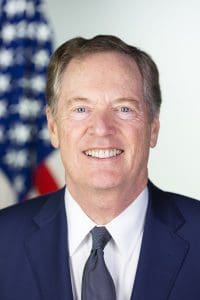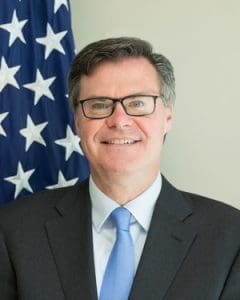
US Trade Representative Robert Lighthizer has drawn up a list of over $200 bn. worth of Chinese imports that will be hit with 10% tariffs if China doesn’t meet US objections to its trade policies.
Trade correspondent L.C. reports: The planned Trump administration tariffs of 10% on $200 bn. of Chinese imports will hit US consumers directly — unlike the previous tariffs, which were on producer goods (steel and aluminum) and thus hit manufacturers first. The list US Trade Representative (USTR) Robert Lighthizer has prepared contains 6,031 products. The tariffs are being justified under Section 301 of US trade law.
The announcement came just four days after the US imposed 25% tariffs on $34 billion of imports from China, which China immediately answered with 25% tariffs on $29.6 billion of its imports from the US. Without a settlement, the US will soon slap 25% tariffs on another $16 billion in Chinese exports, to which China will respond in kind. This will be before the tariffs on $200 billion worth of goods take effect sometime after August.
The $200 billion figure was not a surprise since it had been threatened earlier, but the amount dwarfs even the Section 232 tariffs on steel and aluminum levied on other countries the US trades with. The President had said that if China retaliated against the first tariffs (on the $34 billion), he would raise the stakes by hitting another $200 billion. Now he is carrying out his threat.
The new tariffs won’t immediately take effect because there has to be a public comment period on the products to be targeted and a public hearing, currently scheduled for August 20–23. Since Administration officials claim the point of the tariffs is to force Beijing into negotiations and concessions, it is possible they won’t be imposed. But there were no indications this week that the US and China are about to enter talks that could resolve the matter. Nonetheless, there was some speculation by China specialists that the two sides will meet next month and reach a deal that can be sold as enough of a US win that the worsening trade fight can be called off.
The timing is such that the tariffs on the $200 billion, if they materialize, would take effect probably around the time that the President decides on his proposed Section 232 tariffs on the automotive sector. He wants these measures in place when the fall congressional election campaigns heat up — because he believes they will be welcomed by the Republican Party base. However, the scale and lack of an exit plan for these tariffs has alarmed even many of his supporters on Capitol Hill.
Beijing has begun to urge Chinese enterprises to shift suppliers from the US to other nations, with the EU expected to be a main beneficiary. The Trump administration runs a risk that the defensive actions taken by China and other US trading partners could leave the US with worse trade deficits than before.
China is raked over coals at its bienniel WTO Trade Policy Review

Ambassador Dennis Shea, the Deputy United States Trade Representative and Chief of Mission to the WTO
China underwent its 7th biennial Trade Policy Review (TPR) at the World Trade Organization (WTO), beginning July 11th. Not surprisingly, it provided a forum for the US, represented by WTO Ambassador Dennis Shea, to air again its charges about abusive Chinese trade practices. That the TPR began a day after the US announced its intention to impose tariffs on another $200 billion in Chinese exports heightened the tension.
Importantly, Shea also used the occasion to lay out US grievances about what the US sees as the WTO’s inability to deal with China’s abuses, making it clear that the US thinks the WTO as well as China is under scrutiny.
Japan as well as some other major WTO members including the EU also raised concern about China’s policies regarding state intervention, cybersecurity, and excess capacity, while some noted that China has been reforming some policies. China had allies, including some who welcomed the Belt & Road Initiative as “an avenue for mutual cooperation and growth.”
At the end of the TPR, the body’s chairman (Eloi Laourou of Benin) presented a summary that included a positive assessment (as these summaries usually do): “Members generally expressed appreciation for China’s active role in the WTO” and welcomed China’s recent market-opening and investment-opening initiatives as well as the increasing involvement of the private sector in the economy and its commitment to reforming fossil fuel subsidies. Also, “Members appreciated China’s ongoing reform of customs procedures, such as further use of single windows, and commitments in the Trade Facilitation Agreement.”
But Laourou noted that many members raised serious problems: They “expressed serious concerns about the preponderant role of the State in general, and of SOEs [State-Owned Enterprises] in particular. Some Members felt that State influence in China’s economy has increased in various sectors. [and] that China would require a more market-oriented approach to investment and resource allocation.” They also “raised questions about China’s support and subsidy policies and local content requirements, including those that may be part of the 2025 plan.” Some “noted the importance of enforcing competition policy, particularly in view of the recent amendment to the Anti-Unfair Competition Law…. several also noted continuous issues in China’s IPR [Intellectual Property Rights] regime…. called for more predictability regarding market price support and public [agriculture] stockpiling measures. Other areas of concern raised… included: administrative licensing and approval process, inconsistency in certain sanitary and phytosanitary measures, restrictions on certain agricultural products, cross-border data restriction and data localization requirements, the scope and impact of China’s cybersecurity legislation and restriction of VPN [Virtual Private Network] services, restrictive measures in certain services sectors such as tourism, and industrial policies in certain manufacturing sectors, including… new energy vehicles. Several Members also referred to… market-distorting policies resulting in excess capacity in… steel and semi-conductors…. Members highlighted the importance of fulfilling all WTO commitments…. measures in certain services sectors such as tourism…. Several Members also referred to… market-distorting policies resulting in excess capacity in… steel and semi-conductors…. Members highlighted the importance of fulfilling all WTO commitments…. China has received more than 1,900… questions and has already responded to most of them. This TPR will be successfully concluded in a month’s time, when China replies to all outstanding questions.”
The list of concerns raised shows broad agreement with Washington’s general indictment of Chinese policies. The disagreement is over the US response, which makes it less likely that like-minded WTO members will cooperate in trying to force changes to Chinese behavior.
Click here to go to the previous Founders Broadsheet (“Trade war with China has officially begun; allies also retaliating”)

Leave a Reply